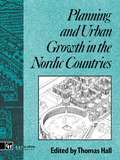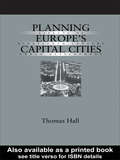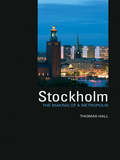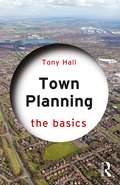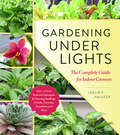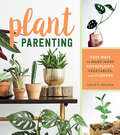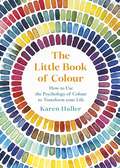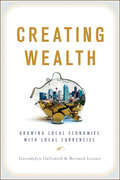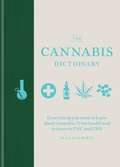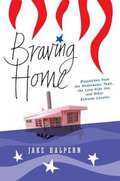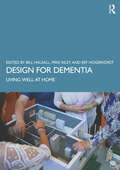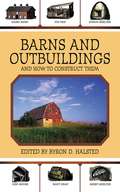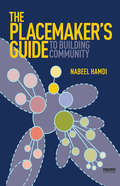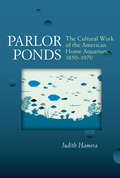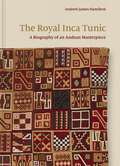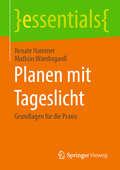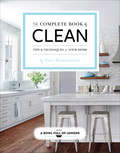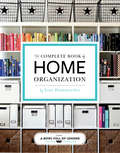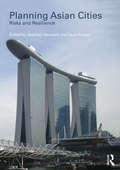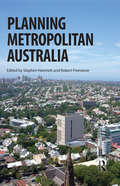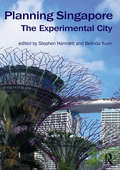- Table View
- List View
Planning and Urban Growth in Nordic Countries (Planning, History and Environment Series)
by Thomas HallPlanning and Urban Growth in Nordic Countries examines urban development and planning in Denmark, Finland, Norway and Sweden. Emphasis is on the period from the mid-nineteenth century to the present day, and the authors of each 'country-study' look at their own national developments against the background of those in other Nordic countries well as the rest of Europe and the USA.
Planning Europe's Capital Cities: Aspects of Nineteenth-Century Urban Development (Planning, History and Environment Series)
by Thomas HallDuring the nineteenth century many of Europe's capital cities were subject to major expansion and improvement schemes. From Vienna's Ringstrasse to the boulevards of Paris, the townscapes which emerged still shape today's cities and are an inalienable part of European cultural heritage.In Planning Europe's Capital Cities, Thomas Hall examines the planning process in fifteen of those cities and addresses the following questions: when and why did planning begin, and what problems was it meant to solve? who developed the projects, and how, and who made the decisions? what urban ideas are expressed in the projects? what were the legal consequences of the plans, and how did they actually affect subsequent urban development in the individual cities? what similarities or differences can be identified between the various schemes? how have such schemes affected the development of urban planning in general?His detailed analysis shows us that the capital city projects of the nineteenth century were central to the evolution of modern planning and of far greater impact and importance than the urban theories and experiments of the Utopians.
Stockholm: The Making of a Metropolis (Planning, History and Environment Series)
by Thomas HallThis is the first history of Stockholm’s development from the city’s unique seventeenth-century redevelopment and extension to the postmodern, postindustrial trends of today. While the city’s planners borrowed the ideas from abroad at certain periods, they provided the lead for the rest of the world at others. For much of the mid-twentieth century Stockholm was the model for Europe and elsewhere. Written by an acknowledged authority on the city and Swedish architecture and planning generally, with a wide range of illustrations, this book provides a much needed explanation of one of Europe’s great cities.
Town Planning: The Basics (The Basics)
by Tony HallThe planning of urban and rural areas requires thinking about where people will live, work, play, study, shop and how they will get about the place, and to devise strategies for long time periods. Town Planning: The Basics provides a general introduction to the components of urban areas, including housing, transportation and infrastructure, and health and environment, showing how appropriate policies can be developed. Explaining planning activity at different scales of operation, this book distinguishes between the "big stuff", the grand strategy for providing homes, jobs and infrastructure; the "medium stuff", the design and location of development; and the "small stuff" affecting mainly small sites and individual households. Planning as an activity is part of a complex web stretching way beyond the planning office, and this book provides an overview of the many components needed to create a successful town. It is invaluable to anyone with an interest in planning, from students learning about the subject for the first time to graduates thinking about embarking on a career in planning, to local councillors on planning committees and community boards.
Gardening Under Lights: The Complete Guide for Indoor Growers
by Leslie F. Halleck“If you want to grow plants indoors, you need this book.” —Niki Jabbour, author and staff writer at savvygardening.comGardening Under Lights is a highly-detailed, accessible guide for seed starters, plant collectors, houseplant fans, and anyone who wants to successfully garden indoors any time of the year. You’ll learn the basics of photosynthesis, the science of light, how to accurately measure how much light a plant needs, and details about the most up-to-date tools and gear available. Also included are tips and techniques for helping ornamental plants (like orchids, succulents, bonsai, and more) and edible plants (arugula, cannabis, oregano, tomatoes, and more) thrive indoors. Whether you are a vegetable gardener who wants to extend the growing season, a balcony gardener short on outdoor space, or a specialty plant collector, Gardening Under Lights is a must-have.
Plant Parenting: Easy Ways to Make More Houseplants, Vegetables, and Flowers
by Leslie F. Halleck“Everything a plant parent needs to take their plant collection—and plant knowledge—to the next level.” —Maria Failla, founder, Bloom & Grow Radio podcast Do you have a passion for houseplants? A desire to grow more tomatoes? Do you want a garden bursting with colorful flowers? No matter what kind of plant fan you are, it’s easy to make more of your favorite plants—and it can be done for free! Plant Parenting is a beginner-friendly introduction to plant propagation. Leslie F. Halleck details the basic tools necessary, demystifies seed starting and saving, and shares easy-to-follow instructions for the most practical techniques for cutting, layering, dividing, and more. She also provides additional information on controlling pests and diseases and transplanting seedlings and cuttings. Charming, richly illustrated, and accessible, Plant Parenting is for anyone looking to make more of their favorite plants.
The Little Book of Colour: How to Use the Psychology of Colour to Transform Your Life
by Karen HallerA SUNDAY TIMES DESIGN BOOK OF THE YEAR_________________________________________The definitive guide for harnessing the power of colour to improve your happiness, wellbeing and confidenceWouldn't you like to boost your confidence simply by slipping on 'that' yellow jumper? Or when you get home after a stressful day, be instantly soothed by the restful green of your walls?The colours all around us hold an emotional energy. Applied Colour Psychology specialist, Karen Haller, explains the inherent power of colour; for example, looking closely at the colours we love or those we dislike can bring up deeply buried memories and with them powerful feelings. A revolutionary guide to boosting your wellbeing, The Little Book of Colour puts you firmly in the driver's seat and on the road to changing the colours in your world to revamp your mood and motivation. Illuminating the science, psychology and emotional significance of colour, with key assessments for finding your own true colour compatibility, this book will help you to rediscover meaning in everything you do through the joy of colour.Get ready to join the colour revolution, and change your life for the better.
Creating Wealth
by Gwendolyn Hallsmith Bernard LietaerLocal currencies have been introduced in thousands of communities around the world in response to the economic crisis because they offer an alternative to money as a way of meeting important human needs. Community leaders can mobilize assets using complementary currencies to address social and economic issues including health care, education, elder care, environmental problems, housing, and food security.
The Cannabis Dictionary: Everything you need to know about cannabis, from health and science to THC and CBD
by Alex HalperinA cannabis revolution is taking place. As people embrace it like never before, The Cannabis Dictionary looks at every aspect of this special plant. Hundreds of entries cover the key information from the cannabis world, from health effects, CBD oil and varieties of the plant, to legalization, big business and psychological impact.Renowned cannabis journalist Alex Halperin is your guide through the many facts and falsehood surrounding the subject, giving an intelligent, in-depth but accessible overview of a fascinating, ever-changing topic.Entries include:420Big WeedBudtendersCannabidiol (CBD)CannatechDabbingGreen OutGreen RushHashMedical MarijuanaMicrodoseParanoiaStrainsTHC... and many more.
The Cannabis Dictionary: Everything you need to know about cannabis, from health and science to THC and CBD
by Alex HalperinA cannabis revolution is taking place. As people embrace it like never before, The Cannabis Dictionary looks at every aspect of this special plant. Hundreds of entries cover the key information from the cannabis world, from health effects, CBD oil and varieties of the plant, to legalization, big business and psychological impact.Renowned cannabis journalist Alex Halperin is your guide through the many facts and falsehood surrounding the subject, giving an intelligent, in-depth but accessible overview of a fascinating, ever-changing topic.Entries include:420Big WeedBudtendersCannabidiol (CBD)CannatechDabbingGreen OutGreen RushHashMedical MarijuanaMicrodoseParanoiaStrainsTHC... and many more.
Braving Home: Dispatches from the Underwater Town, the Lava-Side Inn, and Other Extreme Locales
by Jake Halpern"every journalist has a niche - it's inevitable - and I was just a few days into my career when I stumbled upon mine. It started as a running joke at the office: I was the magazine's Bad Homes Correspondent. The production department quipped about changing my title on the masthead. I laughed it off, but some of the older writers definitely thought there was something wrong with me. "Did you grow up in some sort of dysfunctional household?" a senior editor asked. No, I told him. "Well, there's got to be something in your past that makes you interested in these stories-you ought to think about it." The magazine I worked for was the New Republic, and my co-workers were a mix of policy wonks, art critics, and political junkies. I was none of these, and instead of trying to pass as one, I set out to write a different kind of story; yet every time I did, it ended up being about some outlandish and often hellish place inhabited by a handful of stalwarts who refused to leave. Iron-willed, unfearing, and utterly immovable, these characters captured my imagination. They were the nation's toughest home-keepers, and I was their aspiring chronicler." A fascinating and witty book.
Design for Dementia: Living Well at Home
by Bill Halsall Michael Riley Eef HogervorstDesign for Dementia is written by an interdisciplinary team of professionals and academics whose aim is to present lessons learnt from the Dementia Demonstration House at the Building Research Establishment’s Innovation Park. Known as Chris and Sally’s House, the project represents a unique opportunity to show in practice what can be done to assist people living with dementia to continue to live at home and as part of the community with as much independence as possible. This book presents evidence based practical design guidance backed up by over 15 combined years of research by experienced professional designers.Beginning with an introduction which provides the background to the global dementia epidemic to allow readers to gain a better understanding of the issues they must consider, the book then discusses how good design principles, planning and construction standards can be used to effectively respond to the dementia crisis. The detailed findings from research using Chris and Sally’s House are presented and discussed, along with practical examples and success stories ranging from simple design features to the more complex use of sensors and automated ventilation.The hope is that readers can apply the lessons learnt from Chris and Sally’s House to successfully integrate solutions into the design of new or refurbished housing for the elderly and also that the tools and insights shared will inform the wider context of good housing design, as well as the spectrum of constraints and design standards which often apply. This book is important reading for architects, designers, engineers and project managers, but also anyone with an interest in learning about practical solutions to aid those with dementia to live well at home.
Barns and Outbuildings: And How to Construct Them (Lyons Press Ser.)
by Byron D. HalstedFirst published in 1881, this classic volume presents dozens of practical examples of barns and outbuildings-including floor plans and building instructions-and contains two hundred and fifty-seven engravings, woodcuts, and line drawings illustrating historical and practical designs. Featured designs include cattle barns, pigpens, pigeon houses, self-feeding corncribs, self-closing doors, icehouses, springhouses, granaries, horse barns, dog houses, and much more. Halsted also provides suggestions on the placement of outbuildings and on choosing the cor-rect materials for foundations, walls, and roofs. This new release of Barns and Outbuildings-a tribute to the beauty of the farm and the ingenuity of the farmer-will engage new audiences, from builders and organic gardeners to history buffs and craft lovers.
The Placemaker's Guide to Building Community (Earthscan Tools For Community Planning Ser.)
by Nabeel HamdiFrom the author of Small Change comes this engaging guide to placemaking, packed with practical skills and tools that architects, planners, urban designers and other built environment specialists need in order to engage effectively with development work in any context. Drawing on four decades of practical and teaching experience, the author offers fresh insight into the complexities faced by practitioners when working to improve the communities, lives and livelihoods of people the world over. The book shows how these complexities are a context for, rather than a barrier to, creative work. The book also critiques the single vision top down approach to design and planning. Using examples of successful professional practice across Europe, the US, Africa, Latin America and post-tsunami Asia, the author demonstrates how good policy can derive from good practices when reasoned backwards, as well as how plans can emerge in practice without a preponderance of planning. Reasoning backwards is shown to be a more effective and inclusive way of planning forwards with significant improvements to the quality of process and place. The book also offers a variety of methods and tools for analyzing the issues, engaging with communities and other stakeholders for design and settlement planning and for improving the skills of all involved in placemaking. Ultimately the book serves as an inspiring guide, and a distillation of decades of practical wisdom and experience. The resulting practical handbook is for all those involved in doing, learning and teaching placemaking and urban development world-wide.
Parlor Ponds: The Cultural Work of the American Home Aquarium, 1850-1970
by Judith HameraParlor Ponds: The Cultural Work of the American Home Aquarium, 1850–1970examines the myriad cultural meanings of the American home aquarium during the nineteenth and twentieth centuries and argues that the home aquarium provided its enthusiasts with a potent tool for managing the challenges of historical change, from urbanization to globalization. The tank could be a window to an alien world, a theater for domestic melodrama, or a vehicle in a fantastical undersea journey. Its residents were seen as inscrutable and wholly disposable “its,” as deeply loved and charismatic individuals, and as alter egos by aquarists themselves. Parlor Pondsfills a gap in the growing field of animal studies by showing that the tank is an emblematic product of modernity, one using elements of exploration, technology, science, and a commitment to rigorous observation to contain anxieties spawned by industrialization, urbanization, changing gender roles, and imperial entanglements. Judith Hamera engages advertisements, images, memoirs, public aquarium programs, and enthusiast publications to show how the history of the aquarium illuminates complex cultural attitudes toward nature and domestication, science and religion, gender and alterity, and national conquest and environmental stewardship with an emphasis on the ways it illuminates American public discourse on colonial and postcolonial expansion.
The Royal Inca Tunic: A Biography of an Andean Masterpiece
by Andrew James HamiltonThe hidden life of the greatest surviving work of Inca artThe most celebrated Andean artwork in the world is a five-hundred-year-old Inca tunic made famous through theories about the meanings of its intricate designs, including attempts to read them as a long-lost writing system. But very little is really known about it. The Royal Inca Tunic reconstructs the history of this enigmatic object, presenting significant new findings about its manufacture and symbolism in Inca visual culture.Andrew James Hamilton draws on meticulous physical examinations of the garment conducted over a decade, wide-ranging studies of colonial Peruvian manuscripts, and groundbreaking research into the tunic&’s provenance. He methodically builds a case for the textile having been woven by two women who belonged to the very highest echelon of Inca artists for the last emperor of the Inca Empire on the eve of the Spanish invasion in 1532. Hamilton reveals for the first time that this imperial vestment remains unfinished and has suffered massive dye fading that transforms its appearance today, and he proposes a bold new conception of what this radiant masterpiece originally looked like.Featuring stunning photography of the tunic and Hamilton&’s own beautiful illustrations, The Royal Inca Tunic demonstrates why this object holds an important place in the canon of art history as a deft creation by Indigenous women artists, a reminder of the horrors of colonialism, and an emblem of contemporary Andean identity.
Bathroom Remodeling For Dummies
by Gene Hamilton Katie HamiltonWe're a nation of countless bathrooms that are on the brink of being torn apart, redesigned, and remodeled. Bathrooms are big! They've gone from being a convenience to a luxury. Welcome to Bathroom Remodeling For Dummies, where you'll discover how to transform your bathroom from blah to beautiful and inefficient to well-designed. Remodeling a bathroom is a challenge - it's action-oriented and requires extra energy and stamina. But you, undoubtedly, realize it's a challenge you want to take on. This guide can help if you Want to make your home more livable and enjoyable by updating, expanding, or improving the bathroom Want to find out how to begin the process of appraising your present bathroom so you can improve it Don't want to be pressured into selecting materials and fixtures because you want to see everything that's available and know all your options Want to know what's involved in demolishing the walls and removing the fixtures and cabinets, and how to install new ones Want to decide if you should hire help or do the work yourself Bathroom Remodeling For Dummies is organized to provide lots of useful information that is easily accessible. You'll uncover tips about: Making the most of space in your bathroom Taking control and planning the project Finding fabulous fixtures, vanities, and faucets Decorating the walls, windows, and more Creating storage space You maybe be asking yourself, "Can I remodel my bathroom without spending every penny I have, destroying the harmony of my house, and breaking the spirit of everyone involved?" The answer is yes. Bathroom Remodeling For Dummies can help.
Planen mit Tageslicht: Grundlagen für die Praxis (essentials)
by Renate Hammer Mathias WambsganßNeue Erkenntnisse zur Wichtigkeit ausreichender Tageslichtversorgung im Innenraum haben planungsrelevante Änderungen normativer Vorgaben nach sich gezogen. Renate Hammer und Mathias Wambsganß veranschaulichen die neuen Anforderungen und erläutern die Möglichkeiten zur planerischen Umsetzung. Die Autoren klären, wann Tageslichtversorgung und Besonnung als ausreichend gelten, welche Qualitäten die Sichtverbindung nach außen erfüllen muss und wie Blendung durch Tageslicht zu begrenzen ist. Angaben zur melanopischen Wirkungsweise von Tageslicht bieten einen Einstieg in den planerischen Umgang mit nicht-visuellen Kriterien. Ein weiteres Kapitel zeigt die Schnittstellen mit anderen Aspekten der Bauplanung.Die Autoren:Dr. Renate Hammer studierte Architektur, Solararchitektur und Philosophie in Wien und Krems sowie Urban Engineering in Tokio. 2015 gründete sie das Institute of Building Research & Innovation. Sie unterrichtet einschlägig an der Kunstuniversität Linz und der FH Campus Wien. Prof. Mathias Wambsganß studierte Architektur an der Universität Karlsruhe (TH). 2014 gründete er das Büro „3lpi lichtplaner“ in München. Er ist langjähriges Mitglied im Vorstand der LiTG e.V. und wurde 2007 als Professor an die TH Rosenheim berufen.
The Complete Book of Clean: Tips & Techniques for Your Home
by Toni Hammersley&“Hammersley&’s bible of clean covers every corner of the home from the bathroom to the office…hundreds of tips.&”—The Star From the bestselling author of The Complete Book of Home Organization, this foolproof, eco-friendly guide to cleaning your home provides solutions to help keep every area of your home neat, safe and spotless. Learn the best seasons to tackle home projectsFind storage solutions to simplify the processTeach even the messiest kids to clean up after themselvesKnow what needs a deep-clean—and how oftenSubstitute earth-friendly kitchen supplies for toxic chemicalsTackle every mess, stain and dust-magnet—and keep things from getting out of hand in the future Whether you&’re a neat freak or new to the world of homekeeping, let Toni Hammersley be your guide to establishing routines, learning techniques, and mastering the best home cleaning hacks out there. Soon you&’ll find that no matter the number of pets, kids, or home traffic, maintaining a clean home can be a breeze.
The Complete Book of Home Organization: 200+ Tips And Projects
by Toni HammersleyA &“super useful&” guide to making your home feel more spacious—and your life feel more manageable (Westchester Magazine). Have you ever wished you had the time and tools to organize your house in a clutter-free, design-conscious, Pinterest-worthy way? From storage solutions and cleaning tips to secret space-saving methods and expert strategies, The Complete Book of Home Organization is packed with the tips and shortcuts you need to effectively organize your home. From small spaces and apartment solutions to how to tackle a big, messy home with a 15-week total home organization challenge, this book covers it all. It spells out everything you need to de-clutter your house, store your belongings, and keep your home—and life—in tip-top shape. Organize the 30 main spaces of your home, including the living and dining spaces, bedrooms and bathrooms, guest areas, baby and kids&’ rooms, utility spaces and garages, entryways and offices, patios and decks, closets and pet areas. Keep track of your pantry, holiday and craft supplies, weekly menu planning, keepsakes, and schedules. From the basement to the attic, this book covers every nook and cranny. With step-by-step instructions, detailed illustrations, and handy checklists, it&’s time to say goodbye to a messy home and wasted storage space!
Hydroponic Tomatoes (Into Reading, Level Q #10)
by Heather Hammonds Sharyn MadderNIMAC-sourced textbook. Hydroponic tomatoes are different! They are grown in greenhouses, where they are protected from wildlife and wind. But how do hydroponic tomatoes taste?
Jardines (¡Arriba la Lectura!, Level I #10)
by Heather Hammonds Ben SpibyNIMAC-sourced textbook. ¡Cuesta mucho trabajo mantener un jardín! Pero los jardines son el hogar de animales e insectos, y son lugares hermosos. ¿Qué trabajos importantes puedes hacer en el jardín?
Planning Asian Cities: Risks and Resilience (Planning, History and Environment Series)
by Stephen Hamnett Dean ForbesIn Planning Asian Cities: Risks and Resilience, Stephen Hamnett and Dean Forbes have brought together some of the region’s most distinguished urbanists to explore the planning history and recent development of Pacific Asia’s major cities. They show how globalization, and the competition to achieve global city status, has had a profound effect on all these cities. Tokyo is an archetypal world city. Singapore, Hong Kong and Seoul have acquired world city characteristics. Taipei and Kuala Lumpur have been at the centre of expanding economies in which nationalism and global aspirations have been intertwined and expressed in the built environment. Beijing, Hong Kong and Shanghai have played key, sometimes competing, roles in China’s rapid economic growth. Bangkok’s amenity economy is currently threatened by political instability, while Jakarta and Manila are the core city-regions of less developed countries with sluggish economies and significant unrealized potential. But how resilient are these cities to the risks that they face? How can they manage continuing pressures for development and growth while reducing their vulnerability to a range of potential crises? How well prepared are they for climate change? How can they build social capital, so important to a city’s recovery from shocks and disasters? What forms of governance and planning are appropriate for the vast mega-regions that are emerging? And, given the tradition of top-down, centralized, state-directed planning which drove the economic growth of many of these cities in the last century, what prospects are there of them becoming more inclusive and sensitive to the diverse needs of their populations and to the importance of culture, heritage and local places in creating liveable cities?
Planning Metropolitan Australia (Planning, History and Environment Series)
by Stephen Hamnett Robert FreestoneAustralia has long been a highly (sub)urbanized nation, but the major distinctive feature of its contemporary settlement pattern is that the great majority of Australians live in a small number of large metropolitan areas focused on the state capital cities. The development and application of effective urban policy at a regional scale is a significant global challenge given the complexities of urban space and governance. Building on the editors’ previous collection The Australian Metropolis: A Planning History (2000), this new book examines the recent history of metropolitan planning in Australia since the beginning of the twenty-first century. After a historical prelude, the book is structured around a series of six case studies of metropolitan Melbourne, Sydney, Adelaide, Perth, the fast-growing metropolitan region of South-East Queensland centred on Brisbane, and the national capital of Canberra. These essays are contributed by some of Australia’s leading urbanists. Set against a dynamic background of economic change, restructured land uses, a more diverse population, and growing spatial and social inequality, the book identifies a broad planning consensus around the notion of making Australian cities more contained, compact and resilient. But it also observes a continuing gulf between the simplified aims of metropolitan strategies and our growing understanding of the complex functioning of the varied communities in which most people live. This book reflects on the raft of planning challenges presented at the metropolitan scale, looks at what the future of Australian cities might be, and speculates about the prospects of more effective metropolitan planning arrangements.
Planning Singapore: The Experimental City (Planning, History and Environment Series)
by Stephen Hamnett Belinda YuenTwo hundred years ago, Sir Stamford Raffles established the modern settlement of Singapore with the intent of seeing it become ‘a great commercial emporium and fulcrum’. But by the time independence was achieved in 1965, the city faced daunting problems of housing shortage, slums and high unemployment. Since then, Singapore has become one of the richest countries on earth, providing, in Sir Peter Hall’s words, ‘perhaps the most extraordinary case of economic development in the history of the world’. The story of Singapore’s remarkable achievements in the first half century after its independence is now widely known. In Planning Singapore: The Experimental City, Stephen Hamnett and Belinda Yuen have brought together a set of chapters on Singapore’s planning achievements, aspirations and challenges, which are united in their focus on what might happen next in the planning of the island-state. Chapters range over Singapore’s planning system, innovation and future economy, housing, biodiversity, water and waste, climate change, transport, and the potential transferability of Singapore’s planning knowledge. A key question is whether the planning approaches, which have served Singapore so well until now, will suffice to meet the emerging challenges of a changing global economy, demographic shifts, new technologies and the existential threat of climate change. Singapore as a global city is becoming more unequal and more diverse. This has the potential to weaken the social compact which has largely existed since independence and to undermine the social resilience undoubtedly needed to cope with the shocks and disruptions of the twenty-first century. The book concludes, however, that Singapore is better-placed than most to respond to the challenges which it will certainly face thanks to its outstanding systems of planning and implementation, a proven capacity to experiment and a highly developed ability to adapt quickly, purposefully and pragmatically to changing circumstances.
